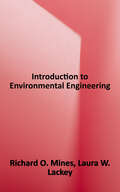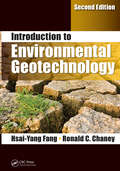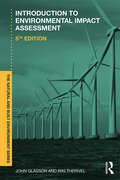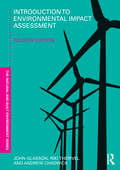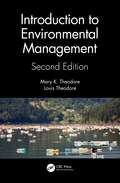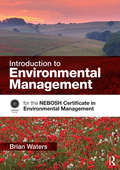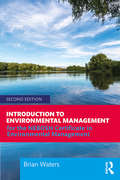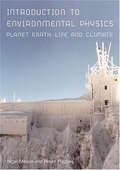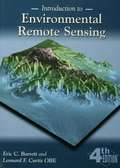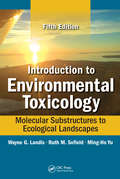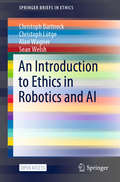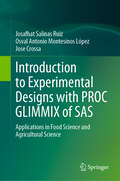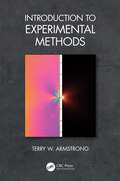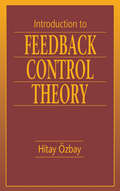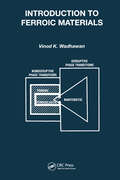- Table View
- List View
Introduction to Environmental Data Analysis and Modeling (Lecture Notes in Networks and Systems #58)
by Moses Eterigho Emetere Esther Titilayo AkinlabiThis book introduces numerical methods for processing datasets which may be of any form, illustrating adequately computational resolution of environmental alongside the use of open source libraries. This book solves the challenges of misrepresentation of datasets that are relevant directly or indirectly to the research. It illustrates new ways of screening datasets or images for maximum utilization. The adoption of various numerical methods in dataset treatment would certainly create a new scientific approach. The book enlightens researchers on how to analyse measurements to ensure 100% utilization. It introduces new ways of data treatment that are based on a sound mathematical and computational approach.
Introduction to Environmental Engineering
by Richard O. Mines Laura W. LackeyFor introductory courses in engineering at the freshmen and sophomore levels at both community colleges and universities. An environmental engineering text for beginning students. In Introduction to Environmental Engineering, authors Richard Mines and Laura Lackey explain complicated environmental systems in easy-to-understand terms, providing numerous examples to reinforce the concepts presented in each chapter.
Introduction to Environmental Geotechnology
by Hsai-Yang Fang Ronald C. ChaneyThis new edition of a bestseller presents updated technology advances that have occurred since publication of the first edition. It increases the utility and scope of the content through numerous case studies and examples and an entirely new set of problems and solutions. The book also has an accompanying instructor's guide and presents rubrics by which instructors can increase student learning and evaluate student outcomes, chapter by chapter. The book focuses on the increasing importance of water resources and energy in the broader context of environmental sustainability. It’s interdisciplinary coverage includes soil science, physical chemistry, mineralogy, geology, ground pollution, and more.
Introduction To Environmental Impact Assessment: Introduction To Environmental Impact Assessment (Natural and Built Environment Series)
by John Glasson Riki TherivelA comprehensive, clearly structured and readable overview of the subject, Introduction to Environmental Impact Assessment has established itself as the leading introduction to EIA worldwide. This fifth edition is a major update reflecting many significant changes in EIA procedures, process, practice and prospects over the last decade. In particular, it includes: a much more international dimension, drawing on EIA activities worldwide; an up-to-date coverage of the revised EU EIA Directive and its implementation; the associated update of contemporary UK procedures and practice; best practice on evolving methods in the EIA process; a rich array of UK and many international case studies; a new coverage of emerging EIA impact topics, including equality/deprivation; culture; resettlement; climate change; ecosystem services; and risk, resilience and cumulative impacts; an appraisal of some next steps in the EIA process, including a more effective and proportionate EIA; the impact of technological change; the changing interpretation of the project; project implementation, monitoring and adaptive management; and moves towards a more integrated impact assessment. Together, these topics act as a kind of action list for future EIA; the development of SEA legislation and practice in the UK, EU and worldwide; and a set of appendices containing key legislation and an EIS review framework. It is also makes full use of colour illustrations and chapter questions for discussion. Written by two authors with extensive research, training and consultancy experience of EIA, this book brings together the most up-to-date information from many sources. Introduction to Environmental Impact Assessment 5th Edition provides a complete, and critical, introductory text that also supports further studies. Students in undergraduate and postgraduate planning programmes will find it essential as a course text, as will students of environmental management/policy, environmental sciences/studies, geography and built environment. Key stakeholders involved in assessment activities – planners, developers, community groups, pressure groups and decision-makers in government and business – will also welcome this latest edition as a very effective means of getting to grips with the many facets of this important and evolving subject that affects a widening range of development projects.
Introduction To Environmental Impact Assessment
by John Glasson Riki Therivel Andrew ChadwickIntroduction to Environmental Impact Assessment provides students and practitioners with a clearly structured overview of the subject, as well as critical analysis and support for further studies. Written by three authors with extensive research, training and practical experience in EIA (Environmental Impact Assessment), the book covers the latest EIA legislation, guidance and good practice. This edition updates essential information on: • the evolving nature of EIA• experience of the implementation of the changing EU and UK EIA procedures• best practice in the EIA process• other key issues in the process, explored in an extended case studies section• comparative EIA systems worldwide• development of SEA/SA legislation and practice• prospects for the future of EIA. Although the book’s focus is on the UK and the EU, the principles and techniques it describes are applicable internationally. With colour images and a new modern design, the book provides an essential introduction to EIA for undergraduate and postgraduate students on planning courses, as well as those studying environmental management and policy, environmental sciences, geography and the built environment. Planners, developers, community groups and decision-makers in government and business will also welcome the book as an effective way to get to grips with this important and evolving subject that affects a wide range of development projects.
Introduction to Environmental Management
by Mary K. Theodore Louis TheodoreWritten at a level that is accessible to students in all disciplines, Introduction to Environmental Management, Second Edition translates complex environmental issues into practical and understandable terms. The book provides students and practitioners an understanding of the regulations, pollutants, and waste management issues that can be applied in various related environmental fields and industries. This new edition is updated throughout and adds eleven new chapters, including coverage of water conservation, water toxins, measurement methods, desalination, industrial ecology, legal issues, and more. Features: Updated throughout and includes eleven all-new chapters Reviews the specialized literature on pollution prevention, sustainability, and the role of optimization in water treatment and related areas, as well as references for further reading Provides illustrative examples and case studies that complement the text throughout Includes ancillary exams and a solutions manual for adopting instructors This book serves as a complete teaching tool, offering a combination of insightful coverage, concise language, and convenient pedagogical features, and supplies practical guidance that will aid students and practitioners alike.
Introduction to Environmental Management: for the NEBOSH Certificate in Environmental Management
by Brian WatersThis endorsed handbook is directly aligned to the NEBOSH Certificate in Environmental Management, with each element of the syllabus explained in detail. Includes sample NEBOSH questions and case studies to aid learning Up to date and aligned with the revised 2012 specification Over 100 images, tables and diagrams, all in full colour Written by an expert in this field of study. Environmental pressures have been increasing on businesses over many years. New legislation has forced companies to look at their impact on the environment through such issues as use of resources, emissions, energy use, transport and waste management. Accidents such as the recent pollution incident by BP in the Gulf of Mexico grab the attention of the media and bring it into the public domain. In addition to its focus on the NEBOSH course, this book covers all of the essential elements managers will need to understand correct environmental health and safety management, including the broad legal framework, risk assessment and pointers to relevant standards. Brian Waters has 15 years’ experience in the water supply industry, and 13 years of experience in senior management roles with the National Rivers Authority and the Environment Agency. He has subsequently worked in training and consultancy, giving him a wealth of experience in this area.
Introduction to Environmental Management: For the NEBOSH Certificate in Environmental Management
by Brian WatersThis book is directly aligned to the NEBOSH Certificate in Environmental Management, which is a qualification aimed primarily at those in business who influence the environmental performance of their organisation by the decisions that they make as managers or the actions that they take as operators. This book aims to provide an introduction to the main areas of concern and how the challenges can be addressed. This new edition takes account of recent changes in international guidance and legislation and the recent update of the International Standard in Environmental Management ISO 14001. The contents are important for businesses that wish to stay within the law and avoid adverse publicity. It explains how the concept of sustainability can be achieved in practice and what benefits – especially financial – that can accrue. Recent developments in the definitions of sustainability and the growing interest in the circular economy are introduced. It pays to be ahead of the game because decisions made now need to reflect an awareness of the coming pressures and there are opportunities available that can bring other benefits. This book is intended for candidates for the NEBOSH qualification, but it will also be useful to anyone who wishes to understand the problems and how they can be tackled within their own organisations, be they industry, public service, voluntary bodies, or even as individuals.
Introduction to Environmental Modeling
by William G. Gray Genetha A. GrayThis textbook presents an understanding of how basic physical descriptions can be translated into mathematical analogues that provide an opportunity to investigate environmental processes. Examples come from a range of hydrologic, atmospheric, and geophysical problems. The emphasis is on simple examples and calculations that add to understanding. The book provides a sense for the meaning of mathematical expressions, a physical feel for their relations to processes, and confidence in working with mathematical solutions. The goal of this book, in essence, is to present the timeless basic physical and mathematical principles and philosophy of environmental modeling, often to students who need to be taught how to think in a different way than they would for more narrowly-defined engineering or physics problems. Minimum prerequisites for the student reader include a knowledge of calculus through differential equations, but the book provides the mathematical and physical tools needed as the occasion arises.
Introduction to Environmental Physics: Planet Earth, Life and Climate
by Peter Hughes N.J. MasonThe changing climate and its affect on all of us is becoming increasingly apparent - ozone depletion, hurricanes, floods and extreme weather behaviour. Introduction to Environmental Physics challenges the way we think about how and why environmental change occurs.This authoritative book aims to cover some of the more common and popular topics a
Introduction to Environmental Remote Sensing
by Eric C. Barrett Leonard F. CurtisTaking a detailed, non-mathematical approach to the principles on which remote sensing is based, this book progresses from the physical principles to the application of remote sensing.
Introduction to Environmental Toxicology
by J P D'MelloIntroduction to Environmental Toxicology is designed as a concise text, introducing students to the fundamentals of this important subject. It covers the origin, characterization and environmental distribution of the major pollutants, and provides an explanation of their implications for human morbidity via the development of cancer, cardiovascular disease, pulmonary dysfunction and neurological conditions. Considering impacts on biodiversity, such as effects from acid rain, heavy metals and selected anthropogenic compounds, this book: - Covers biogenic contaminants, gases and particulates, organic pollutants, petroleum, heavy metals, complex polymers and radiation; - Considers the impact of pollutants across human health, biodiversity, water and food safety; - Includes questions, further reading and case studies to spark discussion in tutorials. Covering all the major biological toxins and pollutants, this book forms a true introduction to the subject for undergraduates studying environmental toxicology and related subjects.
Introduction to Environmental Toxicology: Molecular Substructures to Ecological Landscapes, Fifth Edition
by Wayne Landis Ruth Sofield Ming-Ho YuThe fifth edition includes new sections on the use of adverse outcome pathways, how climate change changes how we think about toxicology, and a new chapter on contaminants of emerging concern. Additional information is provided on the derivation of exposure-response curves to describe toxicity and they are compared to the use of hypothesis testing. The text is unified around the theme of describing the entire cause-effect pathway from the importance of chemical structure in determining exposure and interaction with receptors to the use of complex systems and hierarchical patch dynamic theory to describe effects to landscapes.
Introduction to Enzyme Technology (Learning Materials in Biosciences)
by Karl-Erich Jaeger Andreas Liese Christoph SyldatkThis interdisciplinary textbook provides an easy-to-understand and highly topical introduction to all the specialist areas of modern enzyme technology.In the first part of this three-part textbook, the reader is introduced to the fundamentals of enzyme structure, reaction mechanisms, enzyme kinetics, enzyme modeling, and process control. In the second part, methods for finding, expressing, optimizing, purifying, immobilizing, and using enzymes in unusual reaction media are presented. In the third part, leading experts use examples to describe current applications of enzymes in the chemical and pharmaceutical industries, for biomass degradation, food production and processing, as additives in detergents and cleaning agents, for constructing biosensors, and as therapeutics.Students of bachelor and master programs in biology, chemistry, biochemistry, and bioprocess engineering will gain up-to-date access to practical applications and developing industries. However, the fluent writing style makes the work suitable for all readers, who want to gain an easy-to-understand insight into the production and application of enzymes.This book is a translation of an original German edition. The translation was done with the help of artificial intelligence (machine translation by the service DeepL.com). A subsequent human revision was done primarily in terms of content, so that the book will read stylistically differently from a conventional translation.
Introduction to Epistemology of Mechanical Sciences (History of Mechanism and Machine Science #49)
by Agamenon R. OliveiraThis book investigates the development of mechanical sciences with a focus on epistemological issues. It examines the precursors and fundamental milestones of Newton's theory of motion, a geometry of motion since Greek antiquity, the influences of Robert Hooke on Newton's studies on the orbital motion of the planets, and finally, the orbital motion model with a central force inversely proportional to the square of the distance to this centre. By looking at the development of mechanics throughout history, especially with a careful look at epistemological issues, the book highlights the multiple relationships that the mechanical sciences build with other sciences, the economy, and the popular culture.
Introduction to Ergonomics
by R. S. BridgerThe past decade has seen the development and testing of an increasingly large set of ergonomics tools. With new sections in every chapter, the third edition of Introduction to Ergonomics describes a representative selection of tools and demonstrates how to apply them in practice. In fully researched, stand alone sections with worked examples, the book provides useful, practical skills for dealing with real-world ergonomic problems. The author’s approach is based on a professional model in which specialized skills are backed-up by a good general knowledge of ergonomics. This approach is in accordance with International Ergonomics Association guidelines. <p><p> See what’s new in the Third Edition: <p>• Ergonomics Workshop sections in each chapter with worked examples and advice for using problem solving tools <p>• Guidance for the design of questionnaires, rating scales, and the conduct of surveys applicable across all areas of ergonomics <p>• Task analysis examples together with a wide variety of ergonomics checklists and design guidelines <p>• Increased coverage of the role of stress and psychological well-being on the health of workers and on systems safety <p>• New material for course lectures, examinations, and projects—over 200 essays and exercises <p>• Glossary of technical terms <p>• New evidence for the cost-effectiveness of ergonomics in practice <p>• Advice for further study <p>• Updated Instructor’s Manual <p><p>The book’s built-in flexibility allows it to be used in a variety of ways. Reading the main text supplies a general overview of ergonomics in action. Delving deeper, the Ergonomics Workshop sections include tutorials and exercises that provide a basic toolkit for carrying out risk assessments and for solving real-world problems. This multi-level organization allows those studying human factors, psychology, industrial engineering, and occupational ergonomics to get both general knowledge and specialized information. The self-contained chapters are also accessible to non-ergonomics professionals who need to know more about the subject.
Introduction to Estimating for Construction
by Brian GreenhalghStudents and professionals encountering estimating for the first time need an approachable introduction to its principles and techniques, which is up to date with current practice. Introduction to Estimating for Construction explains both the traditional techniques, and best practice in early contractor involvement situations, within the framework of modern construction procurement. As well as introducing different estimating techniques, it includes: The nature of costs in construction from a cost of resources approach Modern tendering procedures and the stages of development of construction projects How to convert an estimate into a formal tender and then into a contract Simple numerical examples of estimates Estimating and cost analysis during the construction project Summaries and discussion questions in every chapter This is an easy to read introduction to building estimating for undergraduate students, or anyone working in a quantity surveying or construction commercial management role who needs a quick reference.
Introduction to Estimating, Plan Reading and Construction Techniques
by Gary AnglinTo understand Construction Estimating one must also understand plan reading and construction techniques. This book is designed to teach the construction student these three core skills in equal measure. Using hundreds of plans, sketches, and photos, the book builds case studies of the major construction divisions including concrete, masonry, carpentry, and more. Over forty cases are divided into sections following a specially designed format: Plans: Scale drawings of floor plans, sections, or elevations. Plan Interpretation: The drawings are explained with comments. Scope of the Work: A written description of the boundaries of the work is given for each section. Construction Techniques: The construction processes and their sequence are explained. The Takeoff: A takeoff is shown at the end of each section. This approach helps foster confidence in plan reading, building methods, arithmetic, takeoffs, and estimates. The various products and terms used in the industries of structural steel, doors and hardware, and roofing are defined. The shop drawing process is explained, which is so important in many industries, as well as the role of and difference between manufacturers, fabricators, and suppliers/distributors. The book ends with a study of "front end" documents, including Division 00 General Conditions, AIA 201, and Division 01 General Requirements, and a chapter on Ethics. This textbook can be used to teach a variety of classes including plan reading, construction techniques, and estimating 1 and 2 (takeoffs and pricing).
An Introduction to Ethics in Robotics and AI (SpringerBriefs in Ethics)
by Christoph Bartneck Christoph Lütge Alan Wagner Sean WelshThis open access book introduces the reader to the foundations of AI and ethics. It discusses issues of trust, responsibility, liability, privacy and risk. It focuses on the interaction between people and the AI systems and Robotics they use. Designed to be accessible for a broad audience, reading this book does not require prerequisite technical, legal or philosophical expertise. Throughout, the authors use examples to illustrate the issues at hand and conclude the book with a discussion on the application areas of AI and Robotics, in particular autonomous vehicles, automatic weapon systems and biased algorithms. A list of questions and further readings is also included for students willing to explore the topic further.
Introduction to Eurocode 2: Design of concrete structures
by A. Alexandrou D Beckett NfaA concise and practical introduction to the new European Code of Practice for Design of Concrete Structures, EC2. This book guides the reader through the background to the Eurocodes and explains the main differences between them and the equivalent Standard Codes of Practice. An Introduction to Eurocode 2 will be invaluable for engineers who need to
Introduction to Experimental Designs with PROC GLIMMIX of SAS: Applications in Food Science and Agricultural Science
by Josafhat Salinas Ruíz Osval Antonio Montesinos López Jose CrossaIn this book, the subject of design and analysis of experiments has been covered in simple language by giving basic concepts of various designs and essential data analysis steps of designed experiments. It has become clear that among researchers, mainly from the areas of food and agricultural sciences, there is a great need for a reference work on design and analysis of experiments that covers basic concepts, provides examples of varied situations that require the use of the experimental designs and that offers clear steps required for the correct analysis execution. This book covers such needs while also sharing codes in the Statistical Analysis Systems (SAS) for each of the designs covered using Proc Glimmix to perform the analysis. It is hoped that this will allow readers to directly analyze the data from their experiments.
Introduction to Experimental Methods
by Terry W. ArmstrongIntroduction to Experimental Methods succinctly explains fundamental engineering concepts in mechanics, dynamics, heat transfer, and fluid dynamics. From conceptualizing an engineering experiment to conducting a comprehensive lab, this book enables students to work through the entire experimental design process.Offering a complete overview of instruction for engineering lab methodology, the book includes practical lab manuals for student use, directly complementing the instruction. Numerous worked examples and problems are presented along with several hands-on experiments in individual lab manuals. This book discusses how to write lab reports, how to configure a variety of instruments and equipment, and how to work through failures in experimentation.Introduction to Experimental Methods is intended for senior undergraduate engineering students taking courses in Experimental Methods. Instructors will be able to utilize a Solutions Manual for their course.Features: Provides an overview of experimental methods in mechanics, dynamics, heat transfer, and fluid dynamics Covers design of experiments, instruments, and statistics Discusses SolidWorks and PASCO Capstone software Includes numerous end-of-chapter problems and worked problems Features a Solutions Manual for instructor use
Introduction to Feedback Control Theory
by Hitay OzbayThere are many feedback control books out there, but none of them capture the essence of robust control as well as Introduction to Feedback Control Theory. Written by Hitay Özbay, one of the top researchers in robust control in the world, this book fills the gap between introductory feedback control texts and advanced robust control texts.Introduction to Feedback Control Theory covers basic concepts such as dynamical systems modeling, performance objectives, the Routh-Hurwitz test, root locus, Nyquist criterion, and lead-lag controllers. It introduces more advanced topics including Kharitanov's stability test, basic loopshaping, stability robustness, sensitivity minimization, time delay systems, H-infinity control, and parameterization of all stabilizing controllers for single input single output stable plants. This range of topics gives students insight into the key issues involved in designing a controller.Occupying and important place in the field of control theory, Introduction to Feedback Control Theory covers the basics of robust control and incorporates new techniques for time delay systems, as well as classical and modern control. Students can use this as a text for building a foundation of knowledge and as a reference for advanced information and up-to-date techniques
Introduction to Ferroic Materials
by Vinod WadhawanFerroic materials are important, not only because of the improved understanding of condensed matter, but also because of their present and potential device applications. This book presents a unified description of ferroic materials at an introductory level, with the unifying factor being the occurrence of nondisruptive phase transitions in crystals
Introduction to Finite and Spectral Element Methods Using MATLAB
by Constantine PozrikidisIncorporating new topics and original material, Introduction to Finite and Spectral Element Methods Using MATLAB, Second Edition enables readers to quickly understand the theoretical foundation and practical implementation of the finite element method and its companion spectral element method. Readers gain hands-on computational experience by using

